Sol LeWitt (Hartford, EUA- 1928-2007)
Squares with sides and corners torn off
New York, John Weber Gallery, 1977.
Illustrated in black-and-white. No text.
14 x 14 cm.
[32] p.

Joseph Beuys (Alemanha, 1921-1986)
Azione Terza Via: Iniziativa promozionale: Idea e tentativo pratico per realizzare una alternativa ai sistemi sociali esistenti nell’Occidente e nell’Oriente
texto em italiano
Edizione Carte Segrete, 1993 [1978]
80 p.
Esta edição italiana de “Aktion Dritter Weg – aufbauinitiative” foi apresentada oficialmente em 12 de fevereiro de 1978 em Pescara, por ocasião da palestra de Beuys sobre o tema “Istituto per la Rinascita dell’Agricoltura”. O artista apresentou pela primeira vez na Itália a F.I.U. (Free International University), apresentada na Documenta VI, Kassel, no periodo de junho-setembro 1977.
Fonte da imagem: http://www.maremagnum.com/
 Kristján Guðmundsson
Kristján Guðmundsson
Circles
[Amsterdam]: Stedelijk Museum, 1973
500 ex.
A primeira página do livro Circles de Kristján Gudmundsson é feita de papel fino, a página seguinte é de um tipo mais pesado e a terceira página é o mais grosso. Em cada página são retratados círculos que foram causados por uma pedra atirada na água. Tal como é indicado no livro, o peso de cada pedra jogada é equivalente ao peso de cada página. O resultado são os círculos diferentes representados em cada página.
O livro, considerado uma obra de arte, foi publicado em conjunto com a exposição do artista no Museu Stedelijk no final de 1973, em uma edição de 500 cópias. No entanto, o livro foi considerado um catálogo de exposição e aparece listado como o catálogo 550 do museu. Assim, Circles é percebido como um dos primeiros exemplos holandeses de um catálogo que é ao mesmo tempo uma obra de arte autônoma.
The first page in the book ‘Circles’ of Kristján Gudmundsson is made of thin paper, the next page is of a heavier kind and the third page is the thickest. On each page circles in water are depicted that were caused by a stone thrown into the water. As is stated in the book the weight of each thrown stone is equal to the weight of each individual page. The result of the consequently different circles are depicted on each page.
The book, considered a work of art, was published in conjunction with the artist’s exhibition at the Stedelijk Museum in late 1973 in an edition of 500 copies. However, the book is also considered a museum catalogue, listed number 550 in the directory of the museum. Thus, CIRCLES is perceived as one of the earliest Dutch examples of a catalogue that also serves as an autonomous work of art.
AMMCQ AIYCI IAOSA QIEIQ MAOSC OIGOO QIMWI WIAGI YAQA
Anonyme
[56 pag]
offset noir & blanc
18 x 11 cm.
isbn 2-914291-24-8, 5€.
Rennes, Incertain Sens, 2005
![]() Nom(s) de(s) l’auteur(s) crypté(s), titre(s) crypté(s), contenu crypté.
Nom(s) de(s) l’auteur(s) crypté(s), titre(s) crypté(s), contenu crypté.
[Uma parte do livro foi decifrada em março de 2009 por um estudante na escola de arte com a ajuda de um computador]

Peter Downsbrough
Link
Hatje Cantz, 2015
300 ex.
Este é o 100º livro de artista da carreira do artista conceitual americano Peter Downsbrough (1940, New Jersey, vive em Bruxelas) e foi criado para uma exposição realizada em Barcelona (22.02 a 19.05.2013) com todas as suas publicações feitas desde 1968. Link é o resultado de uma colaboração entre o artista e o curador da exposição, Moritz Küng, em que a Hatje Cantz se envolveu como co-editora. A grande particularidade deste livro, que possui apenas algumas páginas e foi impresso em apenas 300 exemplares é que ele não pode ser comprado. Uma sobrecapa especialmente concebida por Downsbrough informa: “Este livro não está à venda e só pode ser adquirido trocando-o por outro livro.“
Veja entrevista com o curador da mostra: http://huskmagazine.com/peter-downsbroughs-link/
Aqui está um livro de valor inestimável, que não pode ser comprado. Como indicado no site da Hatje Cantz, Peter Downsbrough “criou um volume minimalista, delicado, em uma edição limitada de 300, que liga o leitor ao autor: LINK não pode ser comprado, e só pode ser trocado por outro livro, de qualquer tipo. Envie um livro de sua escolha e deixe-se surpreender”. A troca não vai ser possível para sempre, uma vez que existem apenas 300 cópias disponíveis.
Em uma referência circular à arte conceitual, enviei um livro de artista do Lawrence Weiner. Poucos dias depois, veio LINK do Peter Downsbrough, um volume fino, e um gesto simpático. (via artpluspaper)
Here is a priceless book, that can’t be bought.
As stated on Hatje Cantz website, Peter Downsbrough “ has created a minimalist, delicate volume in a limited edition of 300, which connects the reader with the author: LINK cannot be bought, and can only be exchanged for another book, of any sort. Send a book of your choice and let yourself be surprised.” The swap won’t be possible forever, as there are only 300 copies available.
In a circular reference to conceptual art, I sent an artist book by Lawrence Weiner. A few days later came Peter Downsbrough’s LINK, a thin volume, and a nice gesture.
Art & Project Bulletins 1-156: September 1968-November 1989.
offset, p&b
22,5 x 22,5 cm.
84 p.
ISBN 9782953934717
Edição de 1000 cópias.
Cabinet Gallery, London, 20th Century Art Archvies, Cambridge e Christophe Daviet-Thery Paris.
‘Art is to change what you expect from it’ Seth Siegelaub
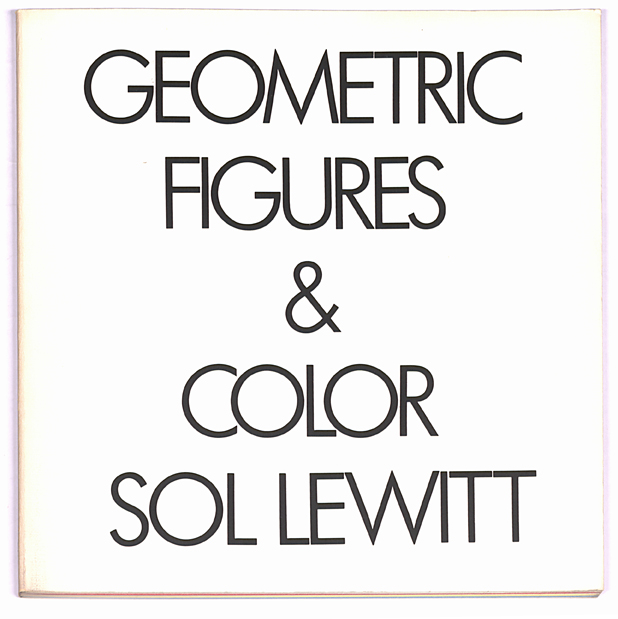 Sol LeWitt
Sol LeWitt
Geometric Figures & Color
New York, NY : Harry N. Abrams, Incorporated, 1979
21 x 21 cm.
ISBN 0-8109-0953-7
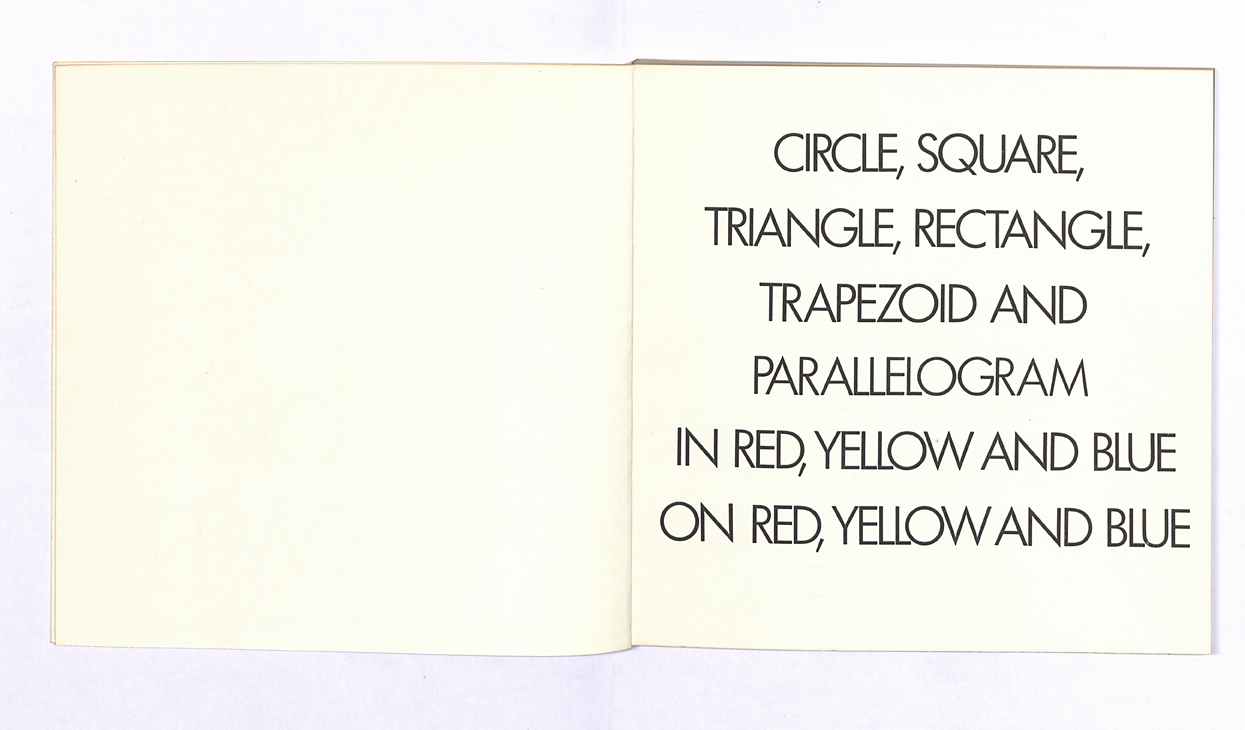
Um programa simples apresenta, desde a folha de rosto, um “círculo, quadrado, triângulo, retângulo, trapézio e paralelogramo em vermelho, amarelo e azul em vermelho, amarelo e azul.” Um bom exemplo da natureza sistemática de LeWitt encontrado em todas as suas obras.
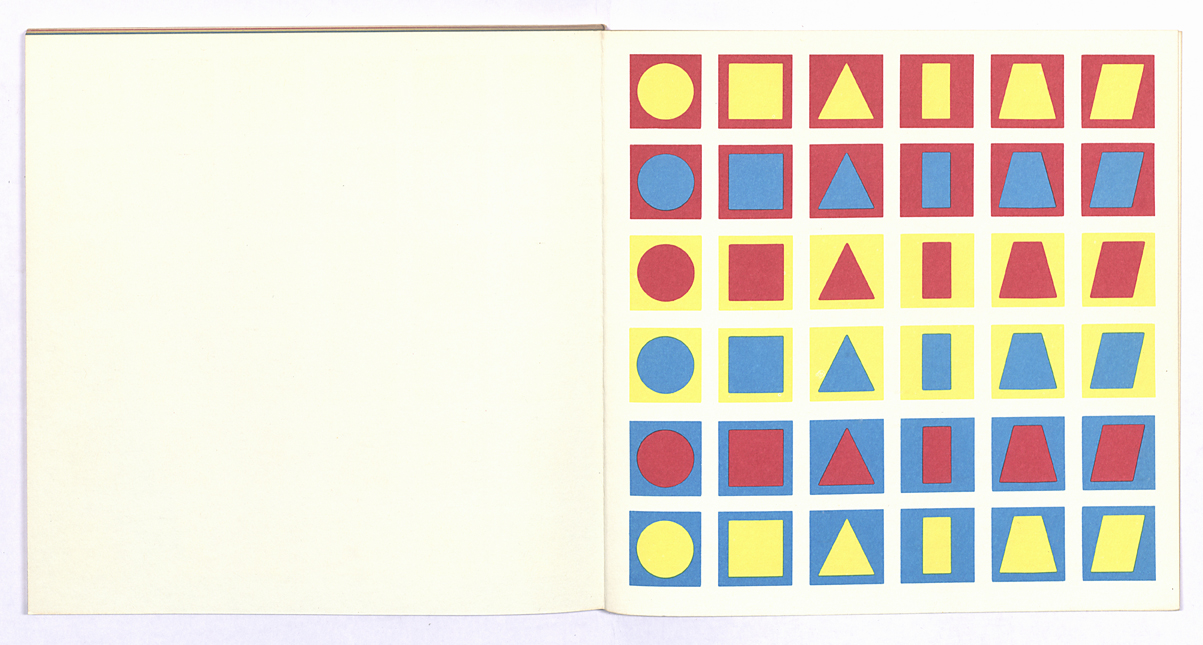
A simple program utilizing, from the colophon, a “circle, square, triangle, rectangle, trapezoid and parallelogram in red, yellow and blue on red, yellow and blue.” A very good example of LeWitt’s systematic progressive nature found in all his works. 
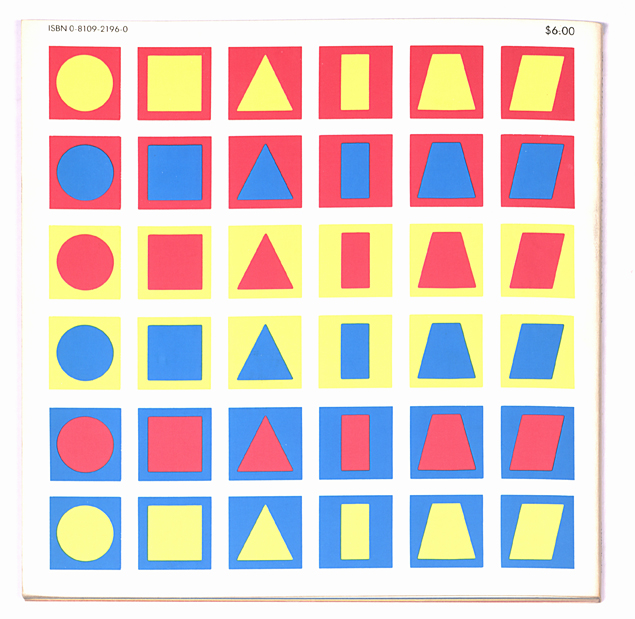 Imagem da contracapa do livro, que funciona como um sumário mostrando uma miniatura de cada página.
Imagem da contracapa do livro, que funciona como um sumário mostrando uma miniatura de cada página.
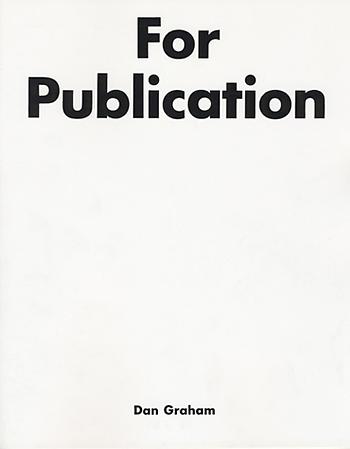
Dan Graham
For Publication
New York, Marian Goodman Gallery, 1991
27.5 x 22.5 cm
Reprint of the 1975 publication from Otis Art Institute Gallery, Los Angeles, which was itself a reprint of Graham’s pageworks of the 1960’s : including “Schema,” “Figurative,” “Information,” “March 31, 1966,” “Detumescence,” Magazine / Advertisments,” “Homes for America,” “Side Effects / Common Drugs,” “Likes,” “A Computer – Astrological Dating – Placement Service,” “Time Extended / Distance Extended,” “Income (Outflow) Piece,” “Proposal for Aspen Magazine,” and “Proposal for Art Magazine.”
… Through the actual experience of running a gallery, I learned that if a work of art wasn’t written about and reproduced in a magazine it would have difficulty attaining the status of ‘art.’ It seemed that in order to be defined as having value, that is as ‘art’, a work had only to be exhibited in a gallery and then to be written about and reproduced as a photograph in an art magazine. Then this record of the no longer extant installation, along with more accretions of information after the fact, became the basis for its fame, and to a large extent, its economic value.
From one perspective, the art object can be analyzed as inseparably connected to the institution of the gallery, or museum; but from another perspective it can be seen as having a certain independence, as it belongs also to the general cultural framework which the magazine is part of. Magazines specialize in a way which replicates other social economic divisions. Any magazine, no matter how generalized, caters to a certain market or specific audience in a particular field. All art magazines are directed to people who are involved in the art world professionally in one way or another. Furthermore, the art magazine itself is supported by advertisements which with one or two exceptions, come from art galleries who are presenting exhibitions. It follows that in some way the advertisers have to be taken care of in that their shows have to be reviewed and made a matter of record in the magazine. Thus these shows and works are guaranteed some kind of value and can be sold on the market as ‘art’. The fact that sales do take place yields enough money for the gallery to purchase more advertisements in art magazines and to sustain the art system in general.
…
If ‘Minimal’ art took its meaning from the notion that the gallery is an objective support, by comparison ‘Pop’ art took its meaning from surrounding media-world of images. ‘Pop’ wished to undermine the notions of quality in fine art by using mass-produced-cultural content. Since it fed its pictures through the magazines back into popular culture, ‘Pop’ art also made an ironic comment about popular culture to itself. What ‘Pop’ pointed out was that the information media, such as magazines, could be used dialectically with the art system. That is, a work could function in terms of both the art language and the popular language of the media at the same time, commenting upon and placing in perspective the assumptions of each. I designed works for magazine pages which would both be self-defined and would relate through their context, to the surrounding information on the other printed pages …— excerpt from “My Works for Magazine Pages ‘A History of Conceptual Art,'” by Dan Graham, 1985
Disponível em PDF: http://issuu.com/amir_brito/docs/for_publication?e=1780285/10308997

Paperback, wire spiral bound
21 x 27 cm
232 p., black and white
English and German
ISBN 978-0-9569623-4-8
Auf und ab, 3 Jahre der Arbeit, und jetzt erscheinen im Verlag Gebr. König, Köln – New York, die erste Fassung LEHREN UND LERNEN ALS AUFFUEHRUNGSKUENSTE von ROBERT FILLIOU und dem LESER, wenn er will. Unter Mitwirkung von JOHN CAGE, BENJAMIN PATTERSON, GEORGE BRECHT, ALLEN KAPROW, MARCELLE, VERA und BJOESSI und KARL ROT, DOROTHY IANNONE, DITER ROT, JOSEPH BEUYS. Dies ist ein Multibuch. Der Schreibraum des Lesers ist beinahe so umfangreich, wie der des Autors.
Off and on 3 years of work and now Verlag Gebr. Koenig, Koeln – New York publishes the first draft of TEACHING AND LEARNING AS PERFORMING ARTS by ROBERT FILLIOU and the READER if he wishes with the participation of JOHN CAGE, BENJAMIN PATTERSON, GEORGE BRECHT, ALLEN KAPROW, MARCELLE, VERA und BJOESSI and KARL ROT, DOROTHY IANNONE, DITER ROT, JOSEPH BEUYS. This is a Multi – book. The space provided for the reader’s use is nearly the same as the autor’s own.
Depois de 3 anos de trabalho agora a editora Koenig, Colônia – New York publica o primeiro esboço de ENSINAR E APRENDER COMO ARTE PERFORMATIVA, de ROBERT FILLIOU e o leitor, se ele desejar, com a participação de JOHN CAGE, BENJAMIN PATTERSON, GEORGE BRECHT, ALLEN KAPROW, MARCELLE, VERA e BJOESSI e KARL ROT, DOROTHY IANNONE, DITER ROT, JOSEPH BEUYS. Este é um Multi – livro. O espaço previsto para a utilização do leitor é quase o mesmo que do próprio autor.

Detalhe da contracapa, com texto manuscrito de Marcelle Filliou.
O livro está disponível em PDF neste link: http://monoskop.org/images/9/93/Robert_Filliou_Teaching_and_Learning_as_Performing_Arts.pdf
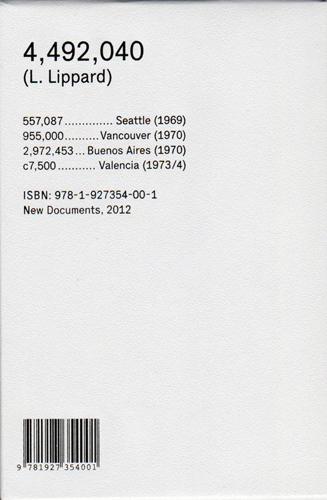
Lucy Lippard (Estados Unidos, 1937)
4,492,040
Vancouver: New Documents, 2012.
358 p.; il. pb.;
10,2 x 15,3 cm
Offset
1000 ex.
ISBN: 978-1927354001
Entre 1969 e 1974, a influente curadora Lucy Lippard (nascida em 1937) curou quatro exposições de arte conceituais decisivas e, ao fazê-lo, reinventou o catálogo de exposição. 4,492,040 é uma reimpressão fac-símile dos catálogos extremamente escassos e extremamente importantes produzidos para essas exposições: 557.087 (Museu de Arte de Seattle), 955.000 (Galeria de Arte de Vancouver), 7.500 (Instituto de Arte da Califórnia) e 2.972.453 (Centro de Arte y Comunicación). Intitulado pelas populações das cidades em que as mostras foram realizadas, cada catálogo era um envelope de cartões soltos contendo declarações, documentação e trabalhos conceituais de cada artista, para serem reorganizados, arquivados ou descartados à vontade. Se Lippard descreveu a arte conceitual como a desmaterialização do objeto de arte, esses catálogos efetivamente anunciaram a desmaterialização da exposição de arte. (Uma resenha afirmava que Lippard era uma artista, e que seu meio de trabalho eram outros artistas.) 4.492.040 inclui figuras iconicas como Vito Acconci, Carl Andre, Siah Armajani, Terry Atkinson, John Baldessari, Michael Baldwin, Robert Barry, Rick Barthelme, Daniel Buren, Hanne Darboven, Walter de Maria, Jan Dibbets, Christos Dikeakos, Eleanor Antin, Dan Graham, Hans Haacke, Eva Hesse, Douglas Huebler, Sobre Kawara, Edward Kienholz Sol LeWitt, Roelof Louw, Duane Lundon, Bruce McLean , Robert Morris, NE Thing Co., Bruce Nauman, Adrian Piper, Allen Ruppersberg, Ed Ruscha, Richard Serra, Robert Smithson, Jeff Wall e Lawrence Weiner.
Between 1969 and 1974, the influential curator Lucy Lippard (born 1937) curated four decisive Conceptual art exhibitions, and in doing so reinvented the exhibition catalogue. 4,492,040 is a facsimile reprint of the extremely scarce and hugely important catalogues produced for those exhibitions: 557,087 (the Seattle Art Museum), 955,000 (the Vancouver Art Gallery), 7,500 (the California Institute of Art) and 2,972,453 (the Centro de Arte y Comunicación). Titled after the populations of the cities in which the shows were held, each catalogue was an envelope of loose note cards containing statements, documentation and conceptual works by each artist, to be rearranged, filed or discarded at will. If Lippard described Conceptual art as the dematerialization of the art object, these catalogues effectively announced the dematerialization of the art exhibition. (One reviewer claimed Lippard had been the artist, and that her medium had been other artists.) 4,492,040 includes such iconic figures as Vito Acconci, Carl Andre, Siah Armajani, Terry Atkinson, John Baldessari, Michael Baldwin, Robert Barry, Rick Barthelme, Daniel Buren, Rosemarie Castoro, Hanne Darboven, Walter de Maria, Jan Dibbets, Christos Dikeakos, Eleanor Antin, Dan Graham, Hans Haacke, Eva Hesse, Douglas Huebler, On Kawara, Edward Kienholz Sol LeWitt, Roelof Louw, Duane Lundon, Bruce McLean, Robert Morris, N.E. Thing Co., Bruce Nauman, Adrian Piper, Allen Ruppersberg, Ed Ruscha, Richard Serra, Robert Smithson, Jeff Wall and Lawrence Weiner.